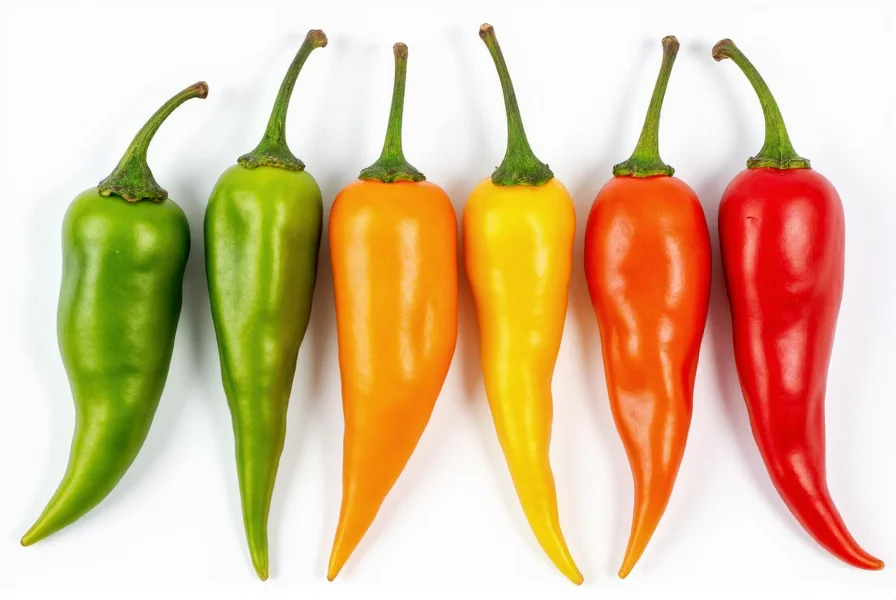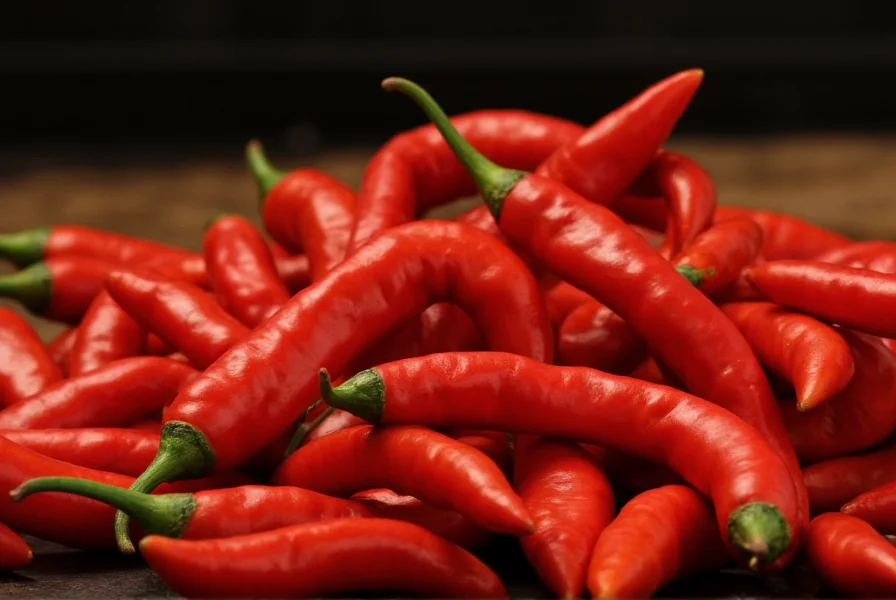Cayenne peppers measure between 30,000 and 50,000 Scoville Heat Units (SHU), placing them firmly in the medium-to-hot range of the chili pepper spectrum. This precise heat rating helps cooks and spice enthusiasts understand exactly how cayenne compares to other popular peppers in terms of capsaicin concentration and perceived spiciness.
Understanding the exact Scoville rating of cayenne peppers is essential for anyone working with this versatile spice. The Scoville scale, developed by pharmacist Wilbur Scoville in 1912, measures the concentration of capsaicinoids—the compounds responsible for a pepper's heat. While many people casually refer to "cayenne" as extremely hot, its actual position on the scale provides important context for culinary applications.
What the Scoville Scale Really Measures
The Scoville Organoleptic Test originally involved diluting chili extracts in sugar water until the heat became undetectable to a panel of tasters. Today, high-performance liquid chromatography (HPLC) provides more precise measurements of capsaicinoid content, which are then converted to Scoville Heat Units. One part capsaicin per million equals approximately 15,000-16,000 SHU.
Cayenne's consistent 30,000-50,000 SHU range makes it significantly hotter than jalapeños (2,500-8,000 SHU) but milder than habaneros (100,000-350,000 SHU). This precise measurement helps explain why cayenne provides noticeable heat without overwhelming a dish—making it ideal for adding controlled spiciness to sauces, rubs, and spice blends.
Factors Affecting Cayenne's Heat Level
Several variables influence where within the 30,000-50,000 SHU range a particular cayenne pepper falls:
- Growing conditions: Soil composition, climate, and water stress can increase capsaicin production
- Ripeness: Fully mature red cayennes typically measure hotter than green or partially ripe specimens
- Genetic variation: Different cayenne cultivars naturally produce varying heat levels
- Plant position: Peppers growing on the upper parts of the plant often develop more heat
Interestingly, the hottest part of the cayenne pepper isn't the seeds as commonly believed, but the white pith or placenta surrounding the seeds. When preparing cayenne peppers, removing this membrane significantly reduces the overall heat while preserving flavor.
| Pepper Variety | Scoville Heat Units | Heat Relative to Cayenne |
|---|---|---|
| Bell Pepper | 0 SHU | 0x (No heat) |
| Jalapeño | 2,500-8,000 SHU | ⅙ to ¼ of cayenne |
| Serrano | 10,000-23,000 SHU | ⅓ to ½ of cayenne |
| Cayenne | 30,000-50,000 SHU | 1x (Reference) |
| Tabasco | 30,000-50,000 SHU | Equal to cayenne |
| Habanero | 100,000-350,000 SHU | 2-7x hotter than cayenne |
| Ghost Pepper | 800,000-1,041,427 SHU | 16-35x hotter than cayenne |

Practical Applications of Cayenne's Heat Profile
Knowing that cayenne measures 30,000-50,000 Scoville units transforms how you use it in cooking. This medium-hot rating makes cayenne ideal for:
- Controlled heat addition: Unlike extremely hot peppers, cayenne allows precise heat adjustment without overwhelming other flavors
- Drying and grinding: The heat remains relatively stable when dried, making cayenne powder a consistent spice option
- Marinades and rubs: Its moderate heat penetrates proteins effectively without causing excessive burning
- Preservation: The capsaicin content acts as a natural preservative in hot sauces and pickled preparations
When substituting cayenne in recipes, remember that ¼ teaspoon of cayenne powder generally equals one fresh cayenne pepper. For those sensitive to spice, start with half the recommended amount and adjust to taste—remembering that heat perception increases over time after consumption.
Common Misconceptions About Cayenne Heat
Several myths persist about cayenne's spiciness:
- Myth: All red chili peppers are equally hot
Reality: Color indicates ripeness, not heat level. Many red peppers like paprika are mild, while some green peppers like habaneros are extremely hot - Myth: Cayenne is one of the hottest common peppers
Reality: At 30,000-50,000 SHU, cayenne falls in the medium-hot range—significantly milder than many specialty peppers - Myth: Seeds contain the most heat
Reality: The placenta (white membrane) holds the highest capsaicin concentration; seeds absorb heat from contact with this membrane
Safety Considerations with Cayenne Peppers
While cayenne's 30,000-50,000 SHU rating makes it manageable for most cooks, proper handling remains important:
- Wear gloves when handling fresh cayenne peppers to prevent skin irritation
- Avoid touching your face, especially eyes, after handling
- If skin contact occurs, use milk or oil to dissolve capsaicin rather than water
- When cooking with dried cayenne, add it gradually to prevent accidental over-spicing
- Keep dairy products nearby when serving cayenne-spiced dishes to help neutralize heat
Understanding that cayenne measures 30,000-50,000 Scoville units provides valuable context for its culinary applications. This precise measurement helps explain why cayenne has become such a popular spice worldwide—it delivers noticeable heat without the extreme intensity of super-hot varieties, making it versatile for everything from Cajun cuisine to traditional Chinese medicine preparations.
Frequently Asked Questions
How does cayenne compare to jalapeño on the Scoville scale?
Cayenne peppers (30,000-50,000 SHU) are significantly hotter than jalapeños (2,500-8,000 SHU). A single cayenne typically measures 4-12 times hotter than a jalapeño. This means you'd need approximately 4-12 jalapeños to match the heat of one cayenne pepper.
Is cayenne pepper the same as red pepper flakes?
Not exactly. While both come from dried chili peppers, cayenne specifically refers to a particular pepper variety measuring 30,000-50,000 SHU. Red pepper flakes typically contain a blend of peppers including cayenne, but may also include milder varieties. Pure cayenne powder is generally hotter and more consistent in heat than generic red pepper flakes.
Can cayenne peppers vary in heat within the same plant?
Yes, significant variation can occur. Peppers growing on the upper parts of the plant typically develop higher capsaicin concentrations (closer to 50,000 SHU) due to more sun exposure, while lower-positioned peppers may measure closer to 30,000 SHU. Even within the same pod, heat distribution varies, with the placenta being hottest.
What's the best way to reduce cayenne's heat in a dish?
Dairy products like milk, yogurt, or sour cream effectively neutralize capsaicin. Acidic ingredients like lemon juice or vinegar can also help balance heat. For prevention, remove the white placenta before cooking, as it contains the highest concentration of capsaicin. Remember that heat perception increases over time, so allow dishes to rest before final seasoning.
How long does cayenne pepper retain its heat when stored?
Properly stored in an airtight container away from light and heat, dried cayenne pepper maintains most of its 30,000-50,000 SHU heat for 2-3 years. Ground cayenne loses potency faster than whole peppers—typically 6-12 months. Freezing extends shelf life significantly while preserving heat levels.











 浙公网安备
33010002000092号
浙公网安备
33010002000092号 浙B2-20120091-4
浙B2-20120091-4